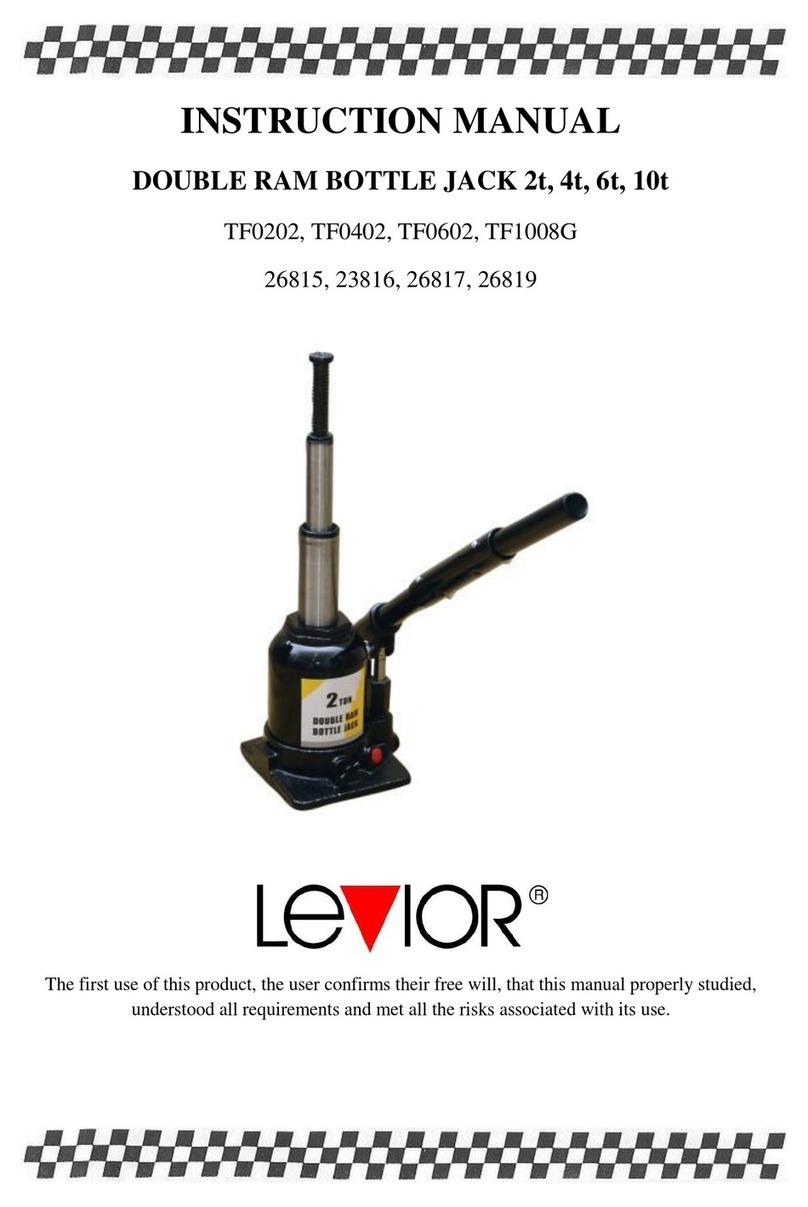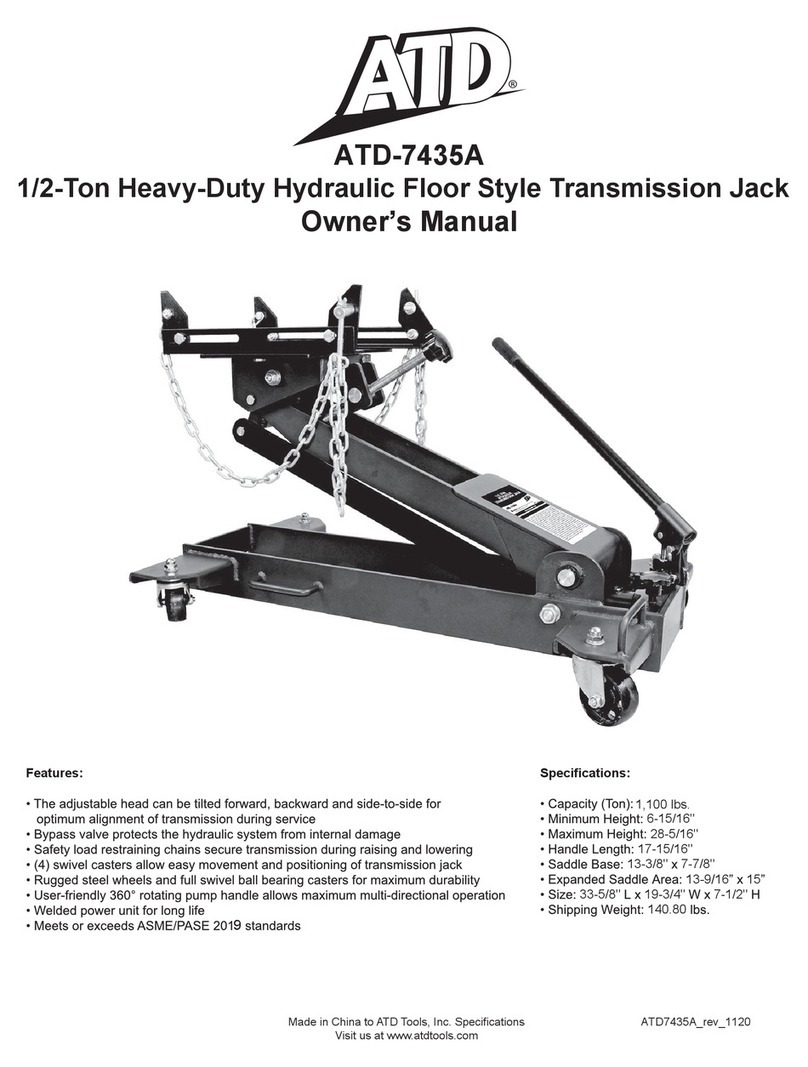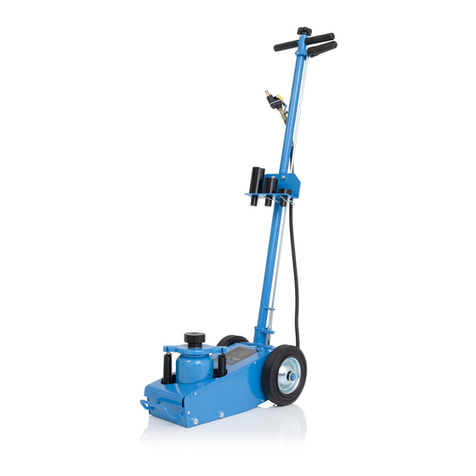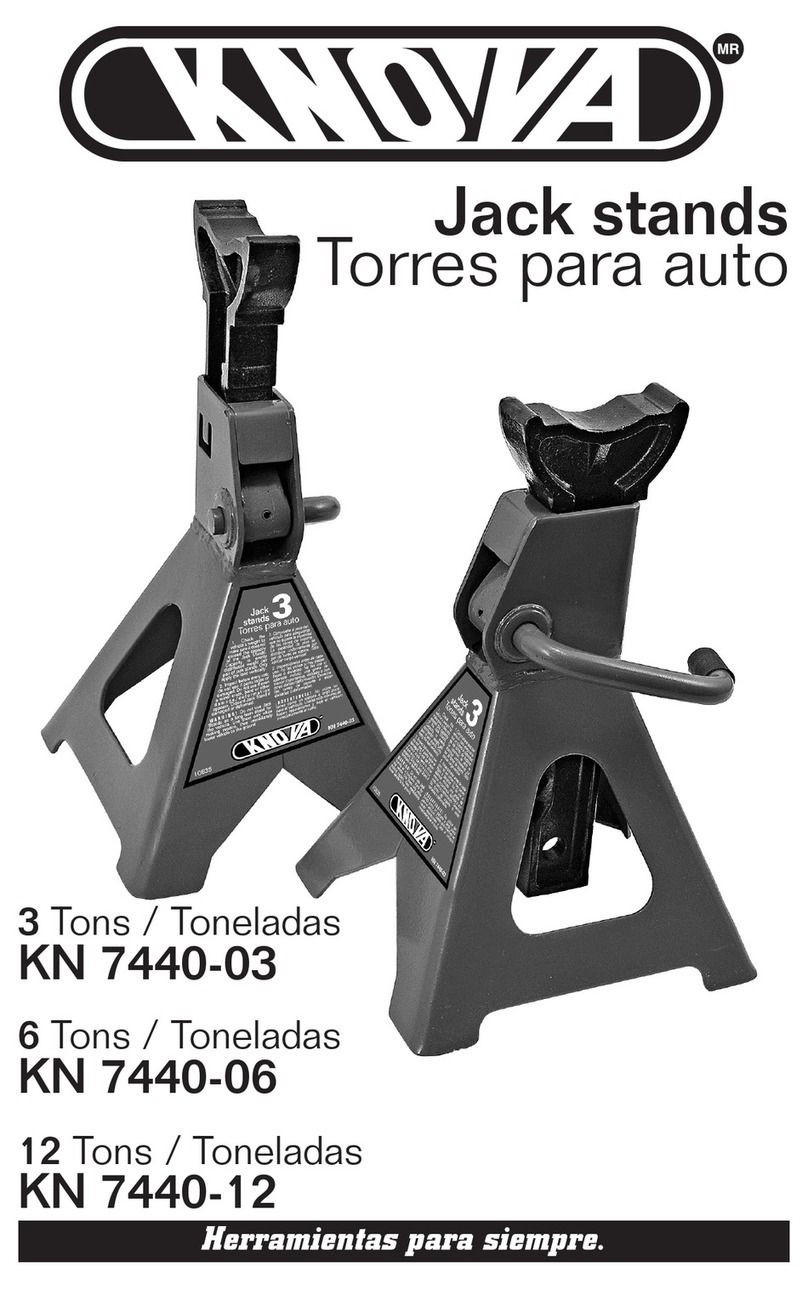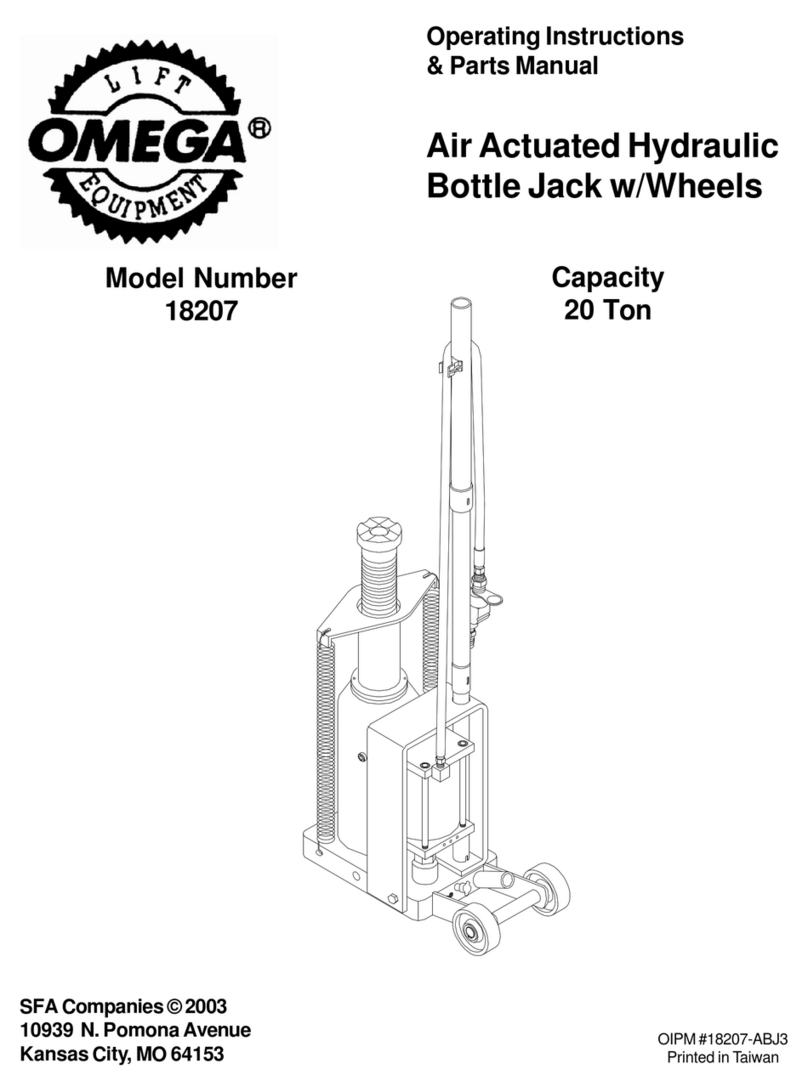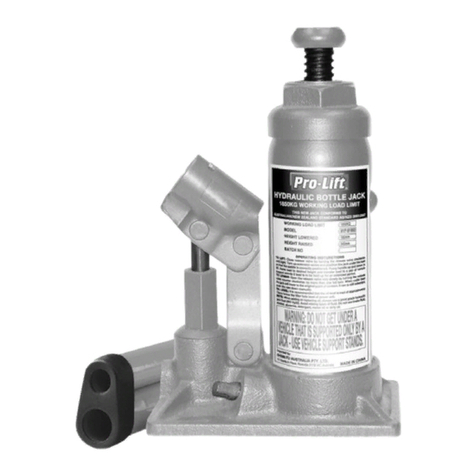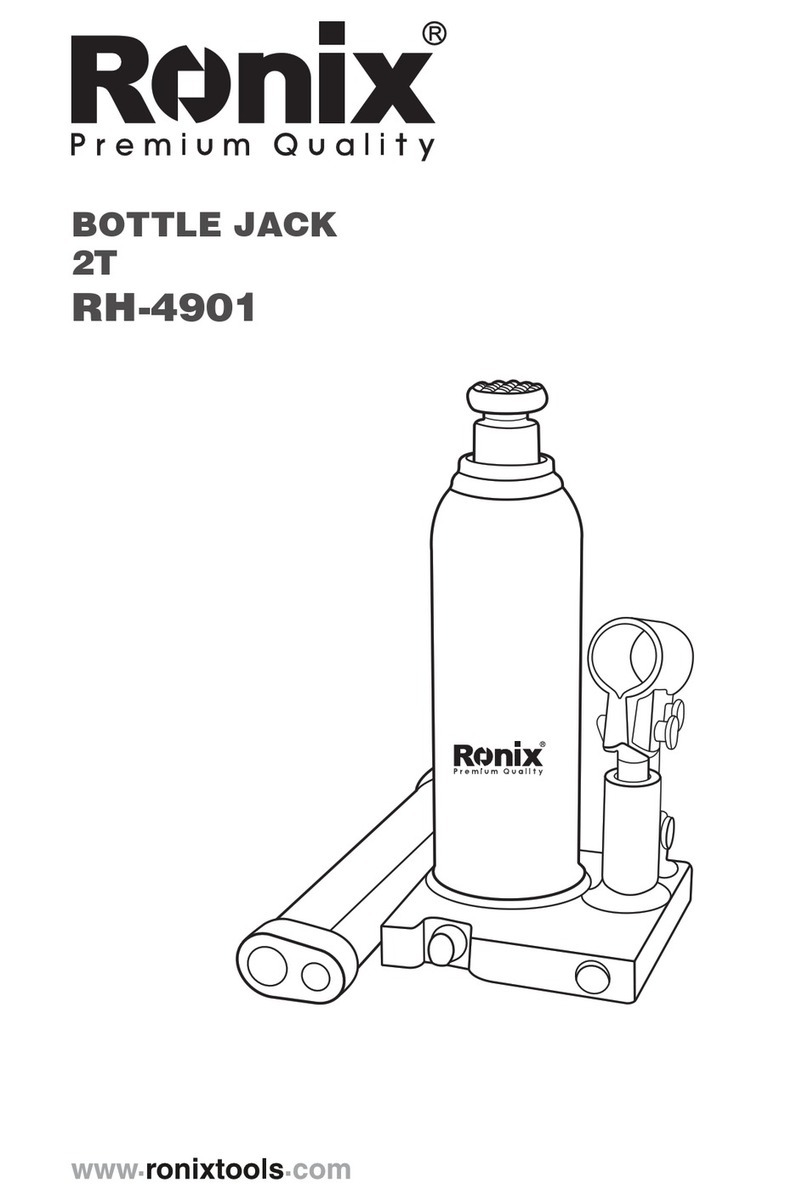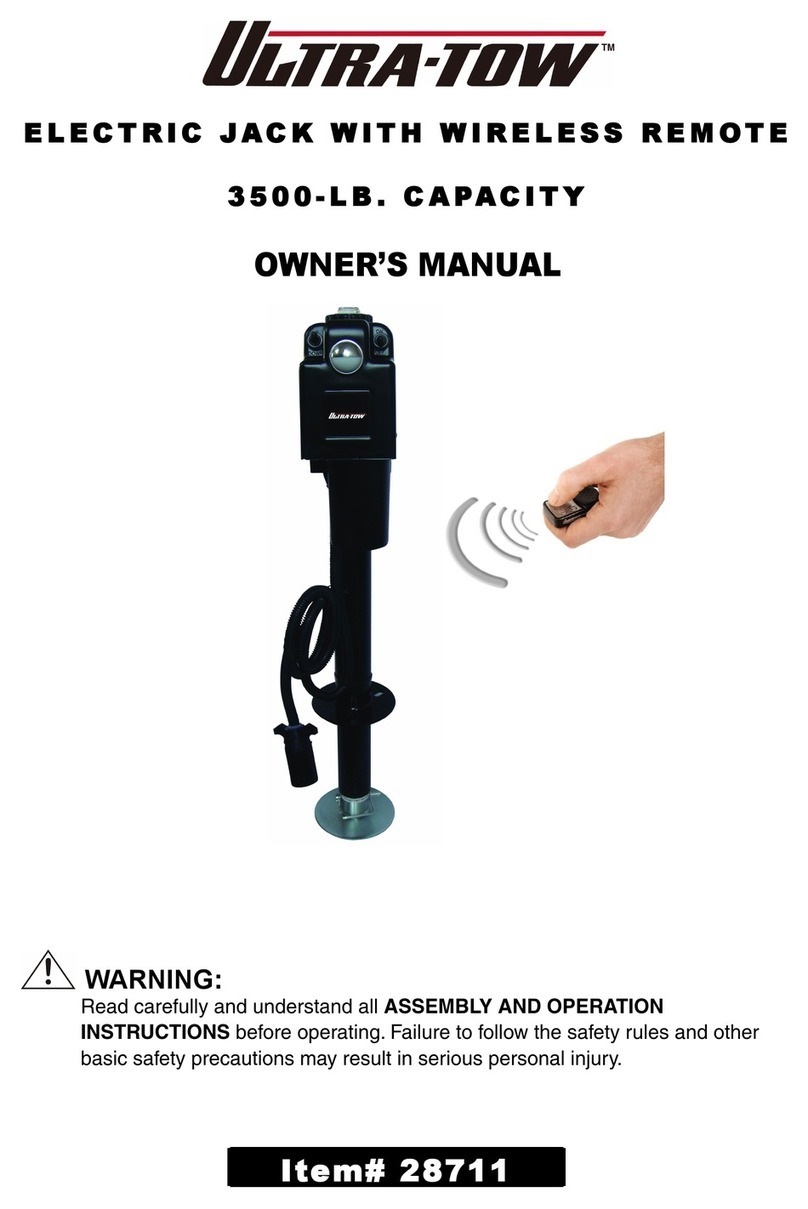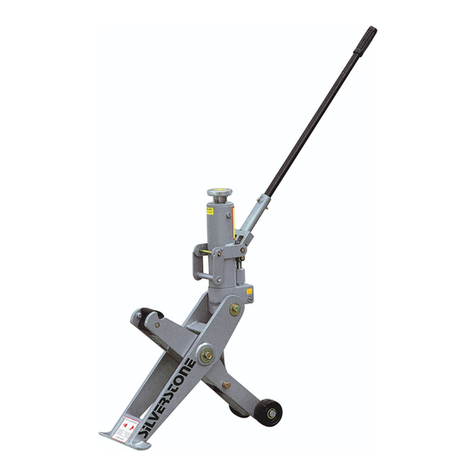Servomech MA Series User manual

Servomech S.p.A. 01.05.TR.E - Rev. 02 DD (M/Y) 12/19 1
ACME SCREW JACKS
MA Series SJ Series
Installation, operation and maintenance manual
Publication: 01.05.TR.E - Rev. 02 Date (M/Y) 12/19
Servomech S.p.A. Via M. Calari, 1 - 40011 Anzola dell’Emilia (BO) - ITALY
Ph: + 39 051 6501711 Fax: + 39 051 734574 www.servomech.com [email protected]

Servomech S.p.A. 01.05.TR.E - Rev. 02 DD (M/Y) 12/19 2
WARNING
Read this manual before installing, operating or maintaining this screw jack. Failure
to follow safety precautions and instructions could cause screw jack failure and result
in serious injury, death or property damage.
This manual provides important information on how to work with the screw jack
safely and efficiently. The manual is part of the device, must always be kept in the
device’s direct proximity and should be available for personnel to read at any time.
Failure to comply with the installation, use and maintenance instructions indicated in
this manual will result in immediate termination of the warranty conditions of the
screw jack and completely relieve Servomech S.p.A. from any liability for damage
caused to persons and / or property.
Servomech S.p.A. it does not assume direct or indirect responsibility for an improper
use of the screw jack, not respecting the performances of the screw jack declared in
the catalogs.
The manufacturer will not be liable for damage to the screw jack or the equipment
into which the screw jack has been installed resulting from:
• disregarding this manual
• unintended use
• employment of untrained personnel
• unauthorized conversions
• technical modifications
• manipulation or removal of the screws on the device
• use of unapproved spare parts
The aforementioned conditions are therefore not contemplated and entail the
immediate termination of the guarantee and the immediate decay of any
responsibility on the part of Servomech S.p.A.
Servomech S.p.A. reserves the right to make changes to the screw jack and this
manual without giving any notice.

Servomech S.p.A. 01.05.TR.E - Rev. 02 DD (M/Y) 12/19 3
ACME SCREW JACKS
MA Series –SJ Series
Installation, operation and maintenance manual
Contents
1 MODELS COVERED BY THIS DOCUMENT....................................................................................................5
2 IDENTIFICATION OF THE MANUFACTURER AND THE PRODUCT................................................................5
2.1 Identification of the manufacturer.....................................................................................................5
2.2 Description of the product .................................................................................................................5
2.2.1 MA Series....................................................................................................................................5
2.2.2 SJ Series ......................................................................................................................................6
2.3 Identification of the product ..............................................................................................................7
3 TRASPORT AND HANDLING ........................................................................................................................8
4 USE RESTRICTION .....................................................................................................................................10
4.1 Intended use.....................................................................................................................................10
4.1.1 Use restrictions.........................................................................................................................10
4.1.2 Standard operating conditions.................................................................................................11
4.1.3 Thermal limit ............................................................................................................................11
4.2 Personnel requirements / Qualifications .........................................................................................11
5 STORAGE...................................................................................................................................................11
6 INSTALLATION ..........................................................................................................................................12
6.1 Safety warnings ................................................................................................................................12
6.2 FCP inductive proximity stroke limit switches..................................................................................13
6.2.1 Adjustable FCP proximity stroke limit switches .......................................................................14
6.3 FCM magnetic stroke limit switches.................................................................................................15
6.4 FC electric stroke limit switches ......................................................................................................17
6.5 Rotary encoder ENC.4 ......................................................................................................................18
6.6 Rotary encoder EH53........................................................................................................................19
6.7 Safety nut MSA and MSB..................................................................................................................20
6.8 Adjustable axial backlash device RMG .............................................................................................21
6.9 Electric motor wiring ........................................................................................................................22
6.9.1 AC 3-phase asynchronous motor .............................................................................................22
6.9.2 AC 1-phase asynchronous motor with balanced winding........................................................24

Servomech S.p.A. 01.05.TR.E - Rev. 02 DD (M/Y) 12/19 4
6.9.3 DC motor ..................................................................................................................................25
6.10 Travelling screw jack (Mod.A) installation .......................................................................................27
6.11 Travelling nut screw jack (Mod.B) installation .................................................................................28
6.12 Installation of screw jack lifting system............................................................................................30
6.13 Installation of fitting elements on threaded end (Mod.A)...............................................................30
7 COMMISSIONING AND USE......................................................................................................................31
8 LUBRICATION............................................................................................................................................32
9 MAINTENANCE .........................................................................................................................................33
9.1 Travelling screw lubrication (Mod.A) ...............................................................................................35
9.2 Travelling nut lubrication (Mod.B) ...................................................................................................35
9.3 Anti-rotation device lubrication (Mod.A) .........................................................................................35
9.4 MA series gearbox lubrication..........................................................................................................36
9.4.1 Lubricant refill...........................................................................................................................36
9.4.2 Lubricant replacement .............................................................................................................36
9.5 SJ series gearbox lubrication ............................................................................................................36

Servomech S.p.A. 01.05.TR.E - Rev. 02 DD (M/Y) 12/19 5
1 MODELS COVERED BY THIS DOCUMENT
The present manual is referred to following products:
Acme screw jacks MA series: MA 5 –MA 10 –MA 25 –MA 50 –MA 80 –MA 100 –MA 200 –MA 350
Acme screw jacks SJ series: SJ 5 –SJ 10 –SJ 25 –SJ 50 –SJ 100 –SJ 150 –SJ 200 –SJ 250 –SJ 300 –SJ 350 –
SJ 400 –SJ 600 –SJ 800 –SJ 1000
2IDENTIFICATION OF THE MANUFACTURER AND THE PRODUCT
2.1 Identification of the manufacturer
SERVOMECH S.p.A. S.U.
Via Monaldo Calari, 1
40011 Anzola dell’Emilia (BO)
ITALY
Ph. +39 051 6501 711
Fax. +39 051 7345 74
Website: www.servomech.com
e-mail: info@servomech.com
2.2 Description of the product
For all the technical characteristics of the product (performance, features, dimensions) refer to the
technical catalog.
2.2.1 MA Series
Figure 2.1 –Main components of MA screw jacks
1) Acme screw
2) Acme nut
3) Screw end
4) Gearbox housing
5) Protective tube
6) Input gearbox shaft
7) Breather plug
8) Oil drain plug
9) Oil level plug
10) Grease nipple
1
1
2
3
3
4
4
5
6
6
7
8
9
10
MA Mod.A –travelling screw
MA Mod.B –travelling nut

Servomech S.p.A. 01.05.TR.E - Rev. 02 DD (M/Y) 12/19 6
2.2.2 SJ Series
Figure 2.2 –Main components of SJ screw jacks
1) Acme screw
2) Acme nut
3) Screw end
4) Gearbox housing
5) Protective tube
6) Input gearbox shaft
7) Acme nut grease nipple
8) Gearbox grease nipple
SJ Mod.A –travelling screw
SJ Mod.B –travelling nut
1
1
2
3
3
4
4
5
6
6
7
8
8

Servomech S.p.A. 01.05.TR.E - Rev. 02 DD (M/Y) 12/19 7
2.3 Identification of the product
Every SERVOMECH screw jack is provided with a nameplate, as shown below, which allows the product
identification and gives technical information about the product.
Figure 2.3 –Identification nameplate
1) Product code: is an alphanumeric code stating the type, size, ratio, version and stroke end switches of
the screw jack;
2) Ratio: is the ratio of the input drive;
3) Stroke length: is the stroke length in millimetres achievable by the screw jack;
4) Linear speed: is the linear speed expressed in mm/s when the screw jack is provided with electric motor;
for a screw jack without motor, this field is blank;
5) Delivery date: is the week/year of assembly (example: 30/13 = week 30 / year 2013) which usually
coincides with the delivery date; this date is considered as reference for the warranty period;
6) Serial number: is the identification number of the screw jack which identifies the exact design of the
product even after a long time; the serial number is the essential reference for spare part orders.

Servomech S.p.A. 01.05.TR.E - Rev. 02 DD (M/Y) 12/19 8
3TRASPORT AND HANDLING
Screw jacks with mounted acme screw and all accessories can be often difficult to handle because of
their overall dimensions. Therefore, it is recommended to pay attention and care during the handling
and transport of screw jack not to damage mechanical parts and / or accessories and to prevent risks
for the personnel in charge of this activity.
The packaging must be lifted and moved with care and in a safe way.
Use only safety-inspected and suitable load hoisting equipment.
Lift the screw jack from the holes on the housing, using slings or eyebolts.
When transporting the product with attached motor, always provide support for the motor, or
remove the motor before transporting the product.
For lifting and transporting travelling screw jack (Mod.A) with protective tube (T), the acme screw
must be in retracted position.
For lifting and transporting travelling screw jack (Mod.A) without protective tube (T), the acme screw
must be in half stroke position.
During lifting operation make sure that the weight of the screw jack is well balanced.
If necessary, provide support for the screw jack from the tube and/or the acme screw.
DO NOT lift the screw jack from the acme screw end or from the tube end.
DO NOT lift the screw jack from the motor.
Prevent the screw jack from swinging during lifting operations.
Figure 3.1 –Transport and handling of MA screw jacks

Servomech S.p.A. 01.05.TR.E - Rev. 02 DD (M/Y) 12/19 9
Figure 3.2 –Transport and handling of SJ screw jacks
Before hoisting the screw jack, check the weight on the following table:
MA 5
MA 10
MA 25
MA 50
MA 80
MA 100
MA 200
MA 350
Mass of the screw
jack w/o acme screw
[kg]
2.2
4.3
13
26
26
48
75
145
Mass for each
100mm acme screw
[kg]
0.16
0.23
0.45
0.8
1.6
1.8
205
5.2
SJ 5
SJ 10
SJ 25
SJ 50
SJ 100
SJ 150
SJ 200
SJ 250
SJ 300
SJ 350
SJ 400
SJ 600
SJ 800
SJ 1000
Mass of the screw
jack w/o acme screw
[kg]
1.5
2.3
10.4
25
35
55
75
75
120
120
260
260
800
800
Mass for each
100mm acme screw
[kg]
0.16
0.23
0.45
0.8
1.6
1.8
2.5
3.4
4.4
5.5
5.5
7.9
10.9
14.2
In case of doubt, consult SERVOMECH S.p.A. to get the appropriate information and prevent any kind of
damage!

Servomech S.p.A. 01.05.TR.E - Rev. 02 DD (M/Y) 12/19 10
4USE RESTRICTION
The information contained in this chapter provides important prescriptions for operating safely during all
phases of the product's life.
Not knowing or not complying with these provisions can generate dangerous situations that could cause
damage to equipment and risks for the safety of persons.
4.1 Intended use
Screw jacks are used to perform very different functions within machines. It is the responsibility of the
machine builder to design the application in compliance with the laws in force in the specific sector and in
the field of safety, in compliance with the requirements provided in the product catalog and in this manual.
SCREW JACKS ARE ELECTRIC AXIS, WHATEVER DRIVER OR CONTROL WILL BE USED: THE SELECTION
OF THE PRODUCT AS STROKE, SPEED, TYPE OF LIMIT SWITCHES, MOTOR AND BRAKE, MUST BE DONE
ACCORDING TO THE BEHAVIOR EXPECTED, IN FUNCTION OF THE TYPE OF CONTROL CHOOSEN AND
THE STATIC AND DYNAMIC BEHAVIOR OF THE SYSTEM IN WHICH THE SCREW JACK IS PLACED!
The screw jacks have been designed and built to operate mobile parts of various types, shapes and
construction, in the ways and within the limits set out in the descriptions and tables of the technical data in
the catalog and in this user manual.
The screw jacks are designed to work with a purely axial applied load.
They must be subjected to the loading and speed conditions specified in the catalog.
Modification of parts of the screw jack or replacement of components with different and non-original parts
is not permitted. The replacement of components with original spare parts is carried out only by Servomech
S.p.A.
Any different use is to be considered improper and therefore potentially dangerous for the safety of the
operators, as well as such as to void the contractual guarantee.
In the event of particular processing requirements, we recommend consulting our sales department.
Every modification must be authorized by Servomech S.p.A. with written documents.
ANY OTHER USE OUTSIDE THAT JUST DESCRIBED IS NOT PERMITTED BY SERVOMECH S.p.A.
4.1.1 Use restrictions
Screw jacks can not be used for unforeseen applications.
Any utilization of this device beyond its intended purpose may lead to potentially hazardous situations.
Therefore:
•Strictly adhere to all safety precautions and instructions in this operating manual.
•Do not allow this device to be subjected to weather conditions, strong UV rays, corrosive or explosive
air media as well as other aggressive media (*).
•Do not modify, retool or change the structural design or individual components of the screw jack.
•Never use the device outside of the technical application and operational limits.
(*) –THE USE OF THE SCREW JACK IN ABOVE CONDITIONS MUST BE PREVIOUSLY DECLARED AND AGREED
WITH SERVOMECH, SINCE A SPECIAL EQUIPMENT OF THE PRODUCT MUST BE PROVIDED.

Servomech S.p.A. 01.05.TR.E - Rev. 02 DD (M/Y) 12/19 11
4.1.2 Standard operating conditions
The screw jacks must be used in an environment whose conditions comply with the provisions of Servomech
S.p.A. The works necessary for obtaining and maintaining that conditions are in charge of the owner and,
where applicable, are in charge of the end user.
The screw jack must be installed and used indoor only, in dry area with environmental conditions as specified
below:
Temperature range +0°C ÷ +40°C
Relative atmospheric humidity 5% ÷ 85%
No build up of condensation
THE USE OF THE SCREW JACK IN DIFFERENT CONDITIONS THAN JUST DESCRIBED MUST BE
PREVIOUSLY DECLARED AND AGREED WITH SERVOMECH, SINCE A SPECIAL EQUIPMENT OF THE
PRODUCT MUST BE PROVIDED.
4.1.3 Thermal limit
The screw jack permissible duty cycle Fi [%] is the maximum working time expressed in percentage that the
screw jack can perform during the reference time period, under rated load stated in the catalogue at ambient
temperature 25°C, without risk of internal parts overheating.
𝑭𝒊[%]=𝑀𝑎𝑥 𝑤𝑜𝑟𝑘𝑖𝑛𝑔 𝑡𝑖𝑚𝑒 𝑜𝑣𝑒𝑟 𝑟𝑒𝑓𝑒𝑟𝑒𝑛𝑐𝑒 𝑡𝑖𝑚𝑒 𝑝𝑒𝑟𝑖𝑜𝑑
𝑟𝑒𝑓𝑒𝑟𝑒𝑛𝑐𝑒 𝑡𝑖𝑚𝑒 𝑝𝑒𝑟𝑖𝑜𝑑 ×100
Permissible duty cycle Fi [%]
MA Series
SJ Series
Fi [%] over 10 min time period
40 %
30 %
Fi [%] over 1 hour time period
30 %
20 %
For the proper operation of screw jack do never exceed the permissible duty cycle limit. For more
informations, please refer to technical catalogue.
4.2 Personnel requirements / Qualifications
This manual must be made available to the personnel in charge of installation, start up and use of the screw
jack. It is the responsibility of the machine builder:
use personnel with the necessary qualifications for the installation and commissioning of the screw
jack;
periodically check the qualification of the assigned personnel;
check that the personnel in charge are aware of the contents of this manual.
5STORAGE
Do not store outside.
Storage should be dry and dust-free.
Keep away from any aggressive media.
Protect from UV radiation.
Avoid mechanical vibrations.
Storage temperature: 0 to +50 °C.
Relative atmospheric humidity: max. 95% (no build up of condensation).
To store longer than 6 months, take care of moving the input shafts to prevent damages to
sealings.
Also check that all unpainted parts are adequately protected (oiled and /or greased) to prevent
oxidation.

Servomech S.p.A. 01.05.TR.E - Rev. 02 DD (M/Y) 12/19 12
6INSTALLATION
The operations described in the paragraphs of this chapter provide both electrical and mechanical
connections of the screw jack, as well as the execution of test motions at reduced speed and motor torque
or with small displacement steps.
6.1 Safety warnings
MOTORS CANNOT BE CONNECTED DIRECTLY TO THE ELETRICITY GRID. A PROPER CIRCUITS AND
DEVICES FOR MOVEMENT MANAGEMENT ON BOTH DIRECTIONS IS REQUIRED. STROKE END LIMIT
SWITCHES (MICROSWITCHES OR SENSORS) MUST BE CONTROLLED TO BE SURE THE LINEAR
MOVEMENT OF THE SCREW JACK (DUE TO THE OPERATION OF THE MOTOR OR TO THE INERTIA OF
THE MOVING PARTS) STOPS BEFORE TO REACH THE MECHANICAL STROKE END LIMITS. IN CASE THIS
HAPPENS, THE SCREW JACK CAN BE LOCKED AND THE INTERNAL COMPONENTS CAN BE DAMAGED.
WHEN THE MOTORS MUST BE POWERED BY A CONVERTER (ELECTRIC DRIVE), THIS MUST BE CHOSEN
BY QUALIFIED PERSONNEL.
IN CASE THERE ARE INVOLVED ELECTRONIC DRIVE AND CONTROL DEVICES ON THE SCREW JACK
MOVING CONTROL, REFER TO MANUALS FOR ALL THE NECESSARY INFORMATION AND CORRECT
INSTALLATION AND MAINTENANCE OF THE PRODUCT.
BEFORE TO PROCEED TO THE ELECTRIC CONNECTION, MAKE SURE THE SUPPLY VOLTAGE IS TURNED
OFF.
BEFORE TO TURN-ON THE MOTOR, MAKE SURE THE ELECTRIC CONNECTIONS ARE TIGHTENED AND
STABLE.
CHECK POWER SUPPLY CABLES NOT TO BE DAMAGED DURING THE COMMISSIONING. POWER
SUPPLY CABLES MUST BE OUT OF HEAT SOURCES AND MOVING ORGANS.
DURING FUNCTIONING ARE PRODUCED MAGNETIC, ELECTRIC AND ELECTROMAGNETIC FIELDS. THIS
MAY BE DANGEROUS FOR PEOPLE THAT USE CARDIAC STIMULATOR (PACEMAKER), IF NOT
SUFFICIENT DISTANCE.
DO NOT DISCONNECT ANY CONNECTION DURING OPERATION OR IN PRESENCE OF SUPPLY VOLTAGE.
BEFORE TO TURN-ON THE MOTOR, MAKE SURE THE MECHANICAL CONNECTIONS OF THE SCREW
JACK REMAIN TIGHTENED AND STABLE, ALSO DURING THE OPERATION.
DURING THE COMMISSIONING, UNEXPECTED MOVEMENT OF THE MOTOR MAY BE CAUSED BY:
WIRING ERRORS
MOUNTING ERRORS
DAMAGES ON POWER SUPPLY CABLES
HARDWARE OR SOFTWARE ERRORS
DRIVER PARAMETERS ERRORS
OPERATION IN CONDITIONS OUTSIDE THE SPECIFICATIONS PROVIDED BY THE
CATALOG AND THIS MANUAL
MAKE SURE THE SAFETY PROTECTION OF THE MACHINE (MECHANICAL AND ELECTRICAL) ARE
ACTIVE.
DURING OPERATION, TEMPERATURE OF THE EXTERNAL SURFACE OF MOTORS OR SCREW JACKS CAN
REACH HIGH TEMPERATURES. HOT SURFACES ON SCREW JACK CAN CAUSE BURNS AND SHOULD NOT
BE TOUCHED.

Servomech S.p.A. 01.05.TR.E - Rev. 02 DD (M/Y) 12/19 13
6.2 FCP inductive proximity stroke limit switches
FCP inductive proximity stroke limit switches are available only for travelling screw jacks (Mod.A).
The INDUCTIVE PROXIMITY STROKE LIMIT SWITCHES allow the screw jack to stop before reaching the internal
mechanical stop avoiding damage. If intermediate sensors are present, they can be used to fix intermediate
positions along the screw jack stroke length. The inductive proximity stroke end switches are fixed directly
on the outer tube in the required position and are activated by a metallic ring fixed on the acme screw end.
The switches position is not adjustable.
The positions of the two limit switches are the extreme travel positions Lc and La (see Fig. 6.15).
FC 1 –sensor for RETRACTED SCREW JACK Lc position
FC 2 –sensor for EXTENDED SCREW JACK La position
Figure 6.1 –FCP inductive proximity stroke limit switches
Dimension P [mm]
MA 5
MA 10
MA 25
MA 50
MA 80
MA 100
MA 200
MA 350
T+FCP
3.5
3.5
3.5
3.5
3.5
3.5
3.5
3.5
T+AR+FCP
3.5
3.5
3.5
3.5
3.5
6
8.5
13.5
TG+FCP
3.5
3.5
3.5
3.5
8.5
8.5
8.5
8.5
TG+AR+FCP
3.5
3.5
3.5
3.5
3.5
6
8.5
13.5
Dimension P [mm]
SJ 5
SJ 10
SJ 25
SJ 50
SJ 100
SJ 150
SJ 200
SJ 250
SJ 300
SJ 350
SJ 400
SJ 600
SJ 800
SJ 1000
T+FCP
3.5
3.5
3.5
3.5
8.5
8.5
3.5
8.5
6
T+AR+FCP
3.5
3.5
3.5
3.5
6
8.5
8.5
13.5
10
Proximity switches are supplied already mounted on the screw jack and set to the correct sensing
distance.
DO NOT CHANGE THE SENSING DISTANCE OF PROXIMITY SWITCHES BY MOVING THE TWO NUTS
FIXED ON THE SENSOR.
In case it is necessary to restore the correct sensing distance position, please refer to Fig. 6.1.
In case the screw jack is not stopped after the sensor activation, when the metal ring moves away,
the sensor restores the original state (becomes deactivated).
In case the limit switches are used to stop the screw jack, we recommend to provide an electric
connection in order to latch the signal and to prevent the screw jack from moving again in the same
direction.
DO NOT TRAVEL OVER THE STROKE LIMIT SWITCHES POSITIONS, AVOIDING TO REACH MECHANICAL
STOP AND PREVENTING DAMAGE TO THE INTERNAL COMPONENTS OF THE SCREW JACK.

Servomech S.p.A. 01.05.TR.E - Rev. 02 DD (M/Y) 12/19 14
6.2.1 Adjustable FCP proximity stroke limit switches
The sensor position along the tube is adjustable in the defined range.
Proximity switches are supplied already mounted on the screw jack and set to the correct sensing
distance.
The two nuts (nut and locknut) to adjust the sensing distance are locked with Loctite 270.
The extreme positions of the two limit switches on the slide are the extreme travel positions Lc and
La (see Fig. 6.15)
To adjust the position of the sensor along the slide (see Fig. 6.2): unscrew the single nut, move the
sensor to the required position, then screw the nut to fix it in position.
DO NOT CHANGE THE SENSING DISTANCE OF PROXIMITY SWITCHES BY MOVING THE TWO NUTS
(NUT AND LOCKNUT) FIXED ON THE SENSOR.
In case it is necessary to restore the correct sensing distance position “P” from the metallic ring (see
Fig. 6.2): unscrew the two preloaded nuts, set the correct sensing distance from the metallic ring,
screw the two nuts in position fixing them with Loctite 270.
Figure 6.2 –adjustable FCP proximity limit switches
The PROXIMITY STROKE LIMIT SWITCHES must be connected to the electric control circuit as shown in the
following WIRING DIAGRAM:
CONTROL CIRCUIT
PROXIMITY SWITCH –TECHNICAL FEATURES
Contact
NC (normally CLOSED)
Type
Inductive, PNP
Voltage
10 ÷ 30 V DC
Max output current
200 mA
Voltage drop (activated
switch)
< 3 V (ref. 200 mA)
Nominal sensing distance
4 mm
Enclosure rating
IP 67
Housing material
Nickel plated brass
Outlet
Multicore PVC cable 3 × 0.2 mm2
length 2 m
Wiring
Screw jack
P [mm]
MA Mod.A Series
2
SJ Mod.A Series
2
Single nut to adjust the sensor position
Nut and locknut to adjust the sensing distance P

Servomech S.p.A. 01.05.TR.E - Rev. 02 DD (M/Y) 12/19 15
6.3 FCM magnetic stroke limit switches
FCM magnetic stroke limit switches are available only for MA/SJ 5, MA/SJ 10, MA/SJ 25 travelling
screw jacks (Mod.A).
The magnetic stroke end switches FCM allow to limit the screw jack stroke length avoiding to reach the
extreme positions (mechanical stop) and preventing damage. Using more switches it is also possible to set
intermediate positions along the screw jack stroke length. Magnetic limit switches are sensors with reed
contact and are fitted with a clamp in the protective tube. They are activated by the magnetic field generated
by a magnetic ring fitted on the travelling acme screw end.
The magnetic reed switches can work only if connected to a control circuit to activate electric relay.
DO NOT connect the reed switches in series between the power supply and the electric motor.
The sensors are activated independently of their angular position on the tube.
When using more contact reeds for intermediate positions, it shall be considered that the same reed
switch can give the signal in 2 different positions, depending on the screw jack motion which can be
retracting or extending.
Figure 6.3 –FCM magnetic stroke limit switches
FCM magnetic limit switches are supplied already fixed on extreme stroke positions Lc and La (see Fig. 6.15):
RETRACTED SCREW JACK (Lc) position: FC 1 reed switch fixed on proper limit marked on the
protective tube.
EXTENDED SCREW JACK (La) position: FC 2 reed switch fixed on proper limit marked on the protective
tube or in contact with the housing cover.
The position of the reed switches can be adjusted by changing the fixing clamp position on the tube:
Release the screw on the fixing clamp (do not release the fixing screw of the reed sensor)
Move the fixing clamp on the tube to the desired position (do not exceed the maximum range Lc …
La)
Fix the screw of the clamp.
In case the screw jack is not stopped after the sensor activation, without magnetic field the sensor
restores the original state.
In case the limit switches are used to stop the screw jack, we recommend to provide an electric
connection in order to latch the signal and prevent the screw jack from moving again in the same
direction.
DO NOT SET THE MAGNETIC SWITCH POSITION OVER THE LIMIT MARK ON THE TUBE.
DO NOT TRAVEL OVER THE STROKE LIMIT SWITCHES POSITIONS, AVOIDING TO REACH MECHANICAL
STOP AND PREVENTING DAMAGE TO THE INTERNAL COMPONENTS OF THE SCREW JACK.

Servomech S.p.A. 01.05.TR.E - Rev. 02 DD (M/Y) 12/19 16
The MAGNETIC LIMIT SWITCHES must be connected to the electric control circuit as shown in the following
WIRING DIAGRAM:
CONTROL CIRCUIT
Normally closed (NC) switches
Normally open (NO) switches
REED SWITCHES –TECHNICAL FEATURES
Contact
NC
NO
Switching output
Reed
Supply voltage
5 ÷ 120 V AC/DC (1)
5 ÷ 230 V AC/DC (2)
Voltage drop
≤ 0.35 V
Continous current
≤ 100 mA (AC)
Switching capacity
≤ 6 W
Protection class
II
Enclosure rating
IP 65
Sensor housing material
Plastic
Clamp material
Stainless steel, Zinc cast
Outlet
Multicore PVC cable 2 × 0.12 mm2
length 2 m
Wiring
BN = brown
BU = blue

Servomech S.p.A. 01.05.TR.E - Rev. 02 DD (M/Y) 12/19 17
6.4 FC electric stroke limit switches
The ELECTRIC STROKE END SWITCHES FC allow to limit the screw jack stroke avoiding to reach the extreme
positions (mechanical stops) and preventing damage. The device consists of two switch assemblies, each of
them consisting of one miniature electric switch (FC 1, FC 2) fixed to the relative support, a switch operating
cam, rotating around the relative support pin when operated by the ferrous-metal ring fixed to the screw
end and a spring that allows the return of the cam to its neutral position, thus deactivating the switch; the
entire assembly is covered by a cover and sealed by a rubber seal.
The activation positions of the two limit switches are the extreme travel positions Lc and La (see Fig.
6.15).
FC 1 –sensor for RETRACTED SCRE JACK (Lc) position
FC 2 –sensor for EXTENDED SCREW JACK (La) position
Figure 6.4 –Electric stroke limit switches FC
The position of the assembly along the outer tube is not adjustable.
The device cannot be used to fix any intermediate position.

Servomech S.p.A. 01.05.TR.E - Rev. 02 DD (M/Y) 12/19 18
The ELECTRIC STROKE LIMIT SWITCHES must be connected to the electric control circuit as shown in the
following WIRING DIAGRAM:
CONTROL CIRCUIT
ELECTRIC SWITCH - TECHNICAL FEATURES
Contact
NC (normally closed)
Supply voltage
250 V AC
125 V AC
125 V DC
Current
(resistive load)
16 A
16 A
0.6 A
Current
(inductive load)
10 A
10 A
0.6 A
Output
2 PVC multicore cables 2 × 0.75 mm2
length 1.5 m
Wiring
DO NOT TRAVEL OVER THE STROKE LIMIT SWITCHES POSITIONS, AVOIDING TO REACH MECHANICAL
STOP AND PREVENTING DAMAGE TO THE INTERNAL COMPONENTS OF THE SCREW JACK.
6.5 Rotary encoder ENC.4
Encoder ENC.4 –TECHNICAL FEATURES
Transducer type
Hall-effect encoder, incremental, bi-directional
Resolution
4 pulses per revolution
Output
PUSH-PULL
2 channels (A and B, phase difference 90°)
Supply voltage
8 ÷ 32 V DC
Max commutable current IOUT
100 mA
Max output voltage drop
with load connected to 0 and IOUT = 100 mA: 4.6 V
with load connected to + V and IOUT = 100 mA: 2 V
Protection
against short circuit
against input polarity inversion
against any incorrect output connection
Cable length
1.3 m
Enclosure rating
IP 55
The rotary encoder ENC.4 must be connected to the electric control circuit as shown in the following
WIRING DIAGRAM:

Servomech S.p.A. 01.05.TR.E - Rev. 02 DD (M/Y) 12/19 19
6.6 Rotary encoder EH53
Encoder EH53–TECHNICAL FEATURES
Transducer type
Optical encoder, incremental, bi-directional
Resolution
100 or 500 pulses per revolution
Output
PUSH-PULL
2 channels (A and B, phase difference 90°)
channel ZERO
Input voltage
8 ÷ 24 V DC
No-load current
100 mA
Max commutable current
50 mA
Cable length
0.5 m
Enclosure rating
IP 54
The rotary encoder ENC.4 must be connected to the electric control circuit as shown in the following
WIRING DIAGRAM:

Servomech S.p.A. 01.05.TR.E - Rev. 02 DD (M/Y) 12/19 20
6.7 Safety nut MSA and MSB
Available for both screw jacks models: with travelling screw (Mod. A) “MSA”, and with travelling nut
(Mod. B) “MSB”.
The safety nut is a back-up feature to prevent the load dropping in an uncontrolled manner in the event of
working nut thread breaking due to overload or achieving of critical wear level (wear level that causes the
breaking of the remaining thread section with normal working load only).
The safety nut is an extension to the standard nut (wormwheel inside Mod.A screw jacks or external travelling
nut of Mod.B screw jacks) and changes the screw jack overall dimensions.
THE SAFETY NUT WORKS WITH ONE PARTICULAR LOAD DIRECTION ONLY. ITS POSITION AS REGARDS
THE STANDARD NUT IS CONDITIONED BY THE LOAD DIRECTION.
Following drawings show a screw jack with safety nut in case of acme screw subjected to push load. In case
of pull load, the position of the nut would be on the opposite side of the screw jack housing (Mod. A) or of
the external travelling nut (Mod. B).
Figure 6.5 –Safety nut
Moreover, with the safety nut it is possible to visualize and to check the state of wear of the working nut
(see Fig. 6.7).
The distance H, measurable by a thickness gauge, is equal to a half of the thread pitch when the
working bronze nut is new.
The distance Hdecreases during the time and indicates the WORKING NUT THREAD WEAR LEVEL.
This manual suits for next models
23
Table of contents
Popular Jack manuals by other brands

VONROC
VONROC TJ501XX manual
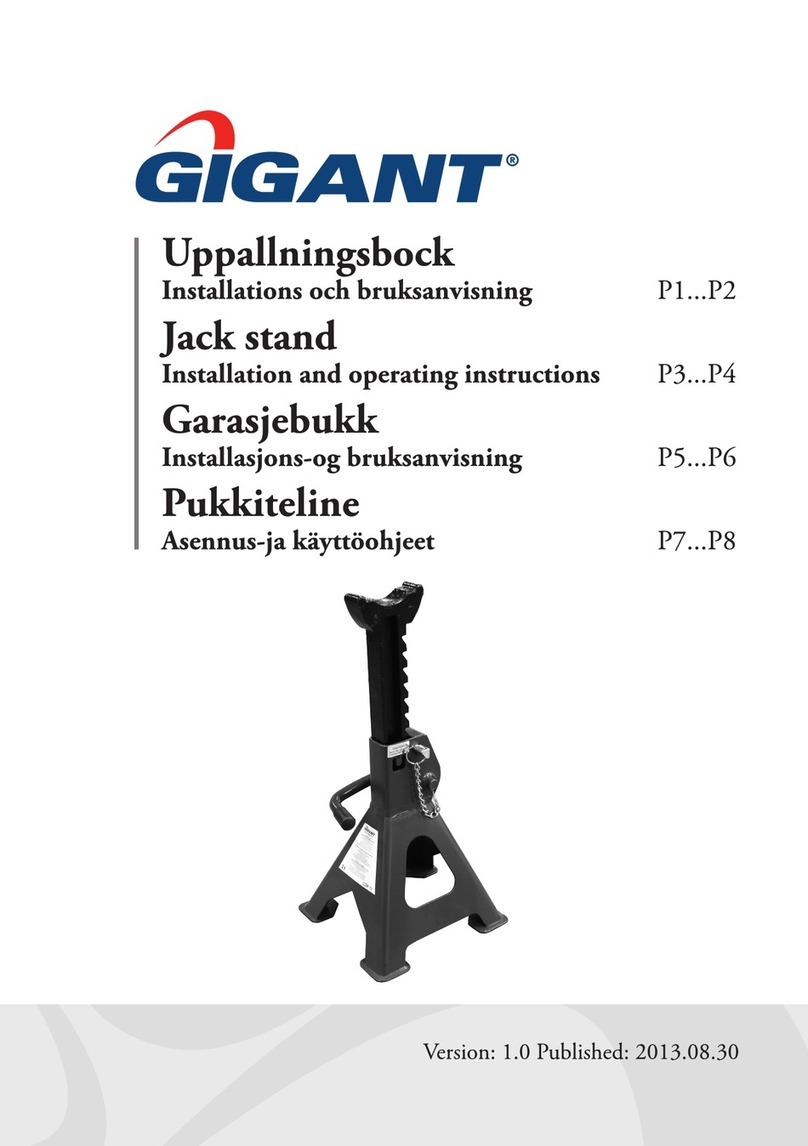
Gigant
Gigant 11948-0101 Installation and operating instructions
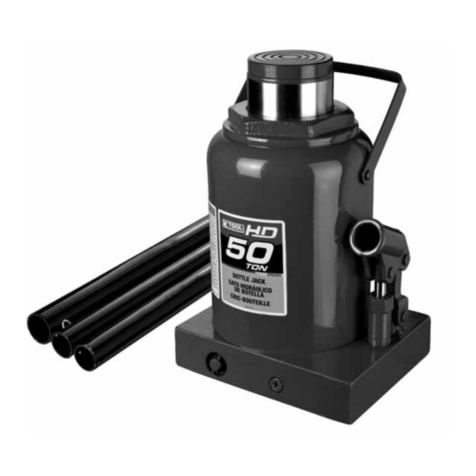
K Tool International
K Tool International KTI63230 owner's manual

HEIN-WERNER AUTOMOTIVE
HEIN-WERNER AUTOMOTIVE HW93662 quick start guide
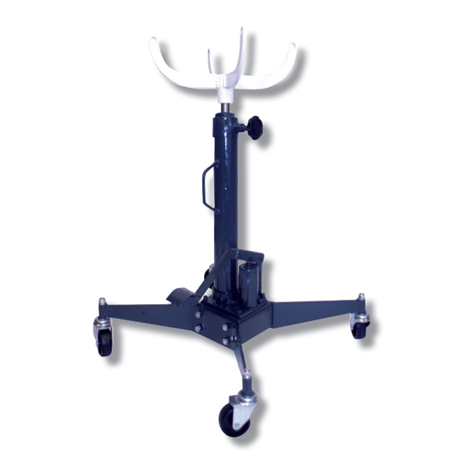
CLAS
CLAS OH 0237 manual
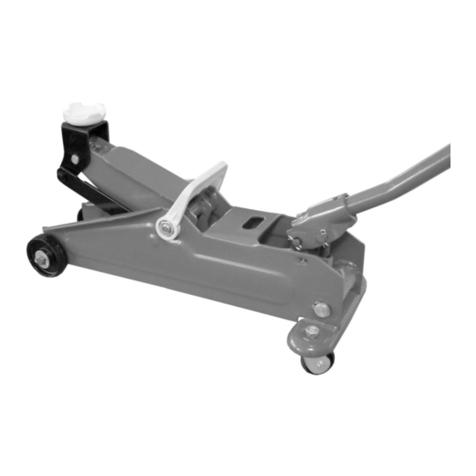
Clarke
Clarke STRONG-ARM CTJ2B Operation & maintenance instructions

